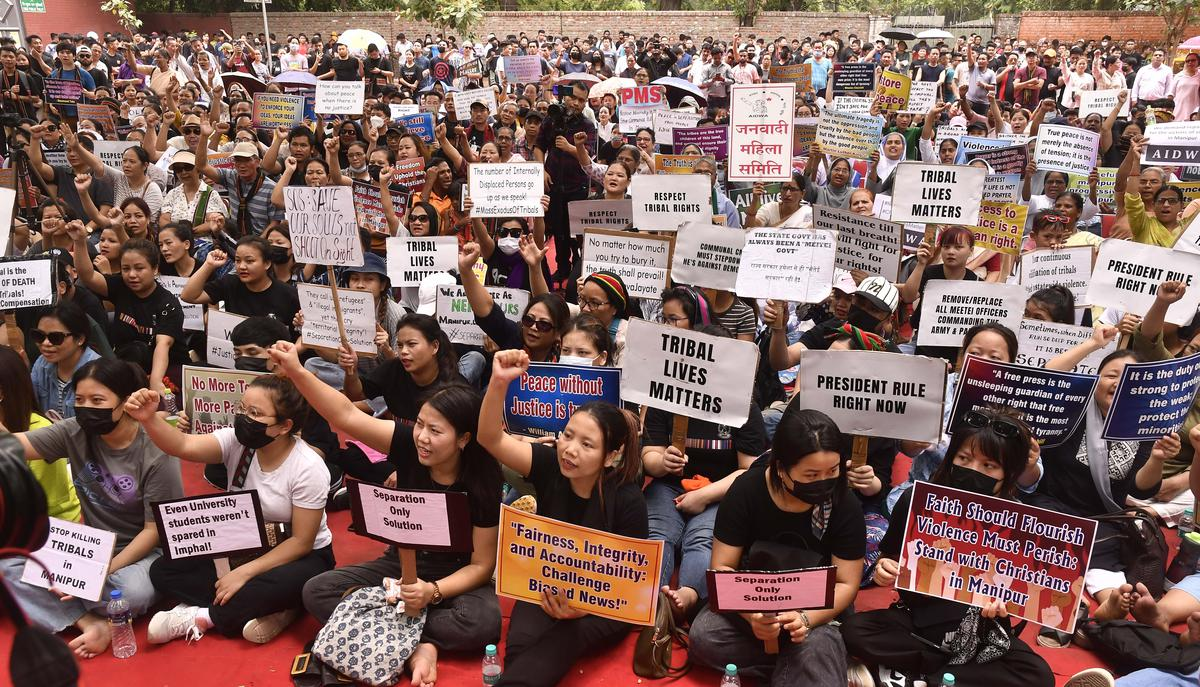Description

Copyright infringement not intended
Picture Courtesy: www.thehindu.com
Context: The Union Government has directed the Manipur State Government to examine a representation sent by Maheshwar Thounaojam, the National Secretary of the Republican Party of India in Manipur, seeking the delisting of certain Kuki and Zomi tribes from the Scheduled Tribes (ST) list of Manipur.
Details
- The move follows the eighth month of ethnic conflict between the valley-based Meitei people and the hills-based Kuki-Zo (ST) people.
- Conflict triggered by an order of the Manipur High Court directing the State government to recommend the Meiteis' inclusion in the ST list to the Centre.
Representation by Thounaojam
- Representation objects to the inclusion of "Any Mizo(Lushai) Tribes," "Zou," and "Any Kuki Tribes" in the ST list, claiming they are not "indigenous" to Manipur.
- Argues that these entries were not mentioned in pre-independence Censuses, and their inclusion has allegedly facilitated illegal immigrants obtaining ST benefits.
.jpg)
Claims and Counter-Arguments
- Indigenous Status: Representation claims a lack of indigenous status for the mentioned tribes. Counter Argument suggests historical documentation contradicts this claim, as these tribes were listed in the first Constitution (Scheduled Tribes) list in 1950.
- Illegal Immigration Facilitation: Representation alleges that the inclusion of these tribes aids illegal immigrants. No empirical evidence supports this claim; the counterargument challenges the assertion as rhetoric without substantial proof.
Historical Recommendations
- First Backward Classes Commission (1955): Recommended individual tribe names for tribes in Assam and Manipur instead of umbrella tribes. Suggested redrawing of ST lists due to outdated information.
- Lokur Commission (1965): Noted a "splintering tendency" among Kuki tribes and recommended mentioning tribe names to address inter-tribe differences. Choose to classify tribes as a larger group with sub-tribes, including synonyms.
- Bhuria Commission Report (2002-2004): Observed confusion regarding the entry "Any Kuki Tribes" in the ST list. Recommended mentioning tribe names to resolve inter-tribe differences.
Current Developments
- Government Response: The Manipur Government was directed by the Centre to examine the representation. The Chief Minister suggests the formation of a special committee to investigate the matter.
- Potential Implications: The representation raises concerns about potential widening of divides among communities in the State. Implications on the criteria used to define groups as STs, with a focus on Meiteis' argument for ST status.
|
Kuki-Zomi Tribes
●The Kuki-Zomi tribes inhabit the northeastern Indian states of Manipur, Nagaland, Assam, Meghalaya, Tripura, and Mizoram, extending into neighbouring Myanmar and Bangladesh.
●Belonging to the Kuki-Chin language family, the Kuki-Zomi tribes share linguistic and cultural affinities with the Chin people of Myanmar and the Mizo people of Mizoram.
●The term "Kuki" has been historically used to encompass a broader grouping, while "Zomi" emerged as a preferred term by some sub-tribes seeking a distinct identity. This complex issue continues to spark debate and discourse.
|
Conclusion
- The Kuki-Zomi tribes, with their rich history, diverse cultures, and unwavering spirit, continue to navigate the challenges of the present while aiming for a brighter future. Acknowledging their unique identities, respecting their cultural heritage, and addressing their concerns are crucial steps towards ensuring their equitable participation and continued contribution to the social fabric of Northeast India and beyond.
Must Read Articles:
KUKIS: https://www.iasgyan.in/daily-current-affairs/kukis
SCHEDULED TRIBES LIST: https://www.iasgyan.in/daily-current-affairs/scheduled-tribes-list
CRITERIA TO DEFINE STs: https://www.iasgyan.in/daily-current-affairs/criteria-to-define-sts
|
PRACTICE QUESTION
Which of the following statements is NOT true about the Kuki-Zomi tribes?
A) They primarily inhabit the northeastern Indian states and extend into neighbouring countries.
B) They share linguistic and cultural similarities with the Chin and Mizo people.
C) They consist of numerous sub-tribes with distinct customs and dialects.
D) They have a homogenous identity and terminology within the group.
Answer: D
Explanation:
The Kuki-Zomi tribes encompass diverse sub-tribes with individual identities and ongoing debates about terminology like "Kuki" and "Zomi."
|















